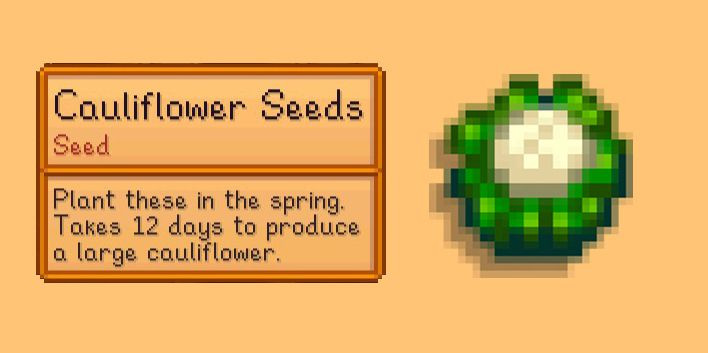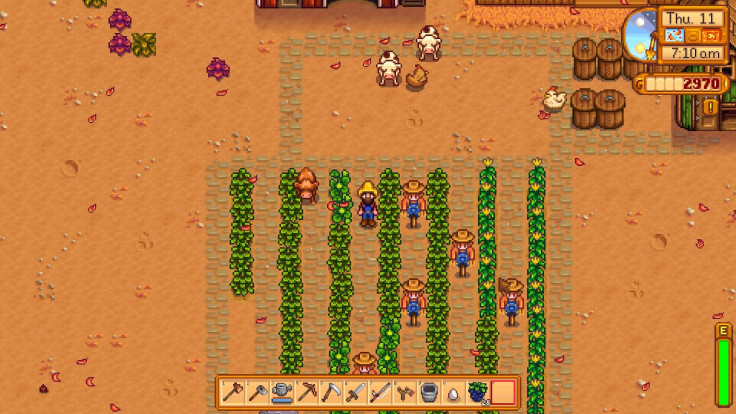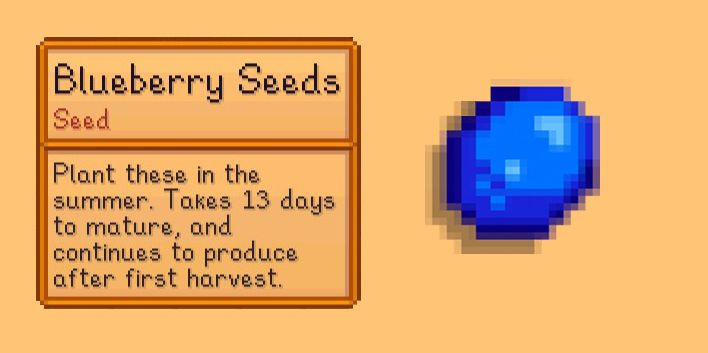Stardew Valley is taking the PC gaming world by storm this week. And we’ve become pretty enamored with the “open-ended country life RPG” here in the Player.One office. Now that we’ve spent a couple of days with the game, it only seemed right to share some tips for a profitable first year on the farm.
Rather than focus on the social and romantic relationships, we spent our first year tending to crops and building new improvements for our farm. The goal is to get the farm set-up in such a way that it requires relatively little time or energy on a daily basis. Players can learn to build sprinklers that eliminate the need to water your crops by hand, reducing your involvement in the process to collecting produce on harvest day. Once your grandfather’s estate is churning out a steady profit again, and you’ve made a few improvements to the house and surrounding land, spending time socializing won’t feel like lost money.
Spring

Primary Crop: Cauliflower
Those interested in building a quick bank roll should focus on growing cauliflower during their first spring. The finished product brings 105 gold profit per plant, more for silver- or gold-star produce, and cauliflower crops can be grown twice per season (with room to spare). It’ll be even more valuable during your second year, after you’ve made some of the upgrades detailed later in this guide.
Of course, it’s always good to have a bit of diversity among your crops. Residents of Pelican Town will frequently post requests for fresh produce on the bulletin board at Pierre’s grocery store. Having a small vegetable garden, with a few non-cauliflower crops, helps ensure your farmer always has the requested produce on-hand. But the vast majority of your spring planting should be focused on cauliflower.
Always Use Fertilizer
Thanks to the abundance of trees on your farm, all of which need to be cleared to get the most out of your land, players shouldn’t ever find themselves at a loss for sap during their first spring. At first, that might not seem like a big windfall. But it only takes two sap to create your own fertilizer, which can be added to tilled soil (before planting new seed) to increase the likelihood of seeing a high-quality plant. When planning large crops, taking the time to fertilize your grow space can yield hundreds of extra gold on harvest day. Fertilizing may become less important as times goes on, if you decide to specialize in preserves and the like, but it’s vital to building up your cash reserves early in the game.

Use Spare Energy To Gather Resources
The first thing players should be doing each morning is watering and/or harvesting their crops. Once that process is complete, any remaining energy should be used to clear the rocks and trees that have overrun your farm. The stone and wood you gather will save you thousands of gold when it comes time to upgrade your farm house, and there’s a good chance you’ll find a couple of geodes – which can be taken to the Blacksmith for examination – full of crafting materials and/or minerals for the museum.
Buy Strawberry Seeds At The Egg Festival
Cauliflower is the best crop for your first spring on the farm but anyone focused on profits will want to replace their cauliflower crops with strawberries in Year Two. Doing so requires a bit of planning, and a willingness to invest cash you won't see a return on until next spring, but it's worth it in the long run. Just mak sure you've got plenty of cash on-hand for the Egg Festival, which takes place on the 13th of Spring, and buy as many strawberry seeds (100g each) as you can afford. Once you get home from the festival, toss them into a chest and leave them there until Year Two begins.
Skip The Coop
It doesn’t take long for Stardew Valley to give players a quest that calls for the construction of a chicken coop. Most people won’t realize how terrible of a decision this is until it’s too late. You are one of the lucky few who’ve been warned. Don’t build that chicken coop.
What Stardew Valley doesn’t tell you is that the chicken coop is basically a glorified resource sink for the first couple of seasons. For starters, you’re going to need 4000 gold, along with 300 wood and 100 stone, to pay the town carpenter. Then you’re going to need another 800 gold per chicken, the smallest coop holds four, and you’ll have to keep a stash of hay at all times to feed the newest additions to your farm. To make matters worse, eggs only sell for 25 gold each, meaning those lucky enough to collect a daily egg from each chicken still only earn 100 gold per day. And it costs 200 gold to fill their feeding tray. The math gets a bit better once you’ve built a mayonnaise machine but this requires even more resources that could be better spent during the early stages of the game.
Don’t build a coop yet. Save your cash to buy a bigger house.
Fish For Cash
During your first few weeks on the warm, players will notice their character still has quite a bit of energy after he/she is finished watering the crops each morning. Once you’ve tended to the crops, pop over to the beach for a couple hours of fishing. In addition to improving your character’s fishing level, spending a few hours on the dock each afternoon will be incredibly fruitful for your savings. It’s not hard to make a quick 500 gold, especially if you take advantage of our fishing guide, and you can even round up the mussels and coral that wash ashore for some extra cash. It’s a great way to keep the money rolling in while you wait for your crops to finish growing.
By the end of spring, there’s a good chance you’ll have the 450 wood and 10K gold needed to buy the first upgrade for your farm house. If so, head over to the carpenter’s place and schedule construction as soon as you have a chance. The first upgrade adds a refrigerator to your farm house, instantly providing the player with an additional 36 slots of storage space for their produce. And that will be handy when it comes time to start harvesting berries in the summer and fall months. If you can’t afford to build the first upgrade by the end of spring, make it your first priority next season.
Summer

Primary Crop: Blueberries
Without a doubt, blueberries are the unrivaled king of summertime crops. Melons might seem like the go-to choice, given their high resale value straight out of the ground (275g) and ludicrous jelly prices (550g). But blueberries get a slight edge over their larger counterparts. For starters, players pull three berries off the vine each time they harvest. The vines also bear fruit multiple times per season, thereby flooding your inventory with dozens (if not hundreds) of berries in a shockingly short timespan. From there, it’s just a matter of deciding whether to make jelly (210g) or sell the raw berries for fast cash.
Repair The Beach Bridge
Most Stardew Valley players will be sitting on a large stash of wood by summer. Obviously, some of it will be need to be saved to upgrade your farm house and the surrounding land. But players shouldn’t hesitate to use 300 wood repairing the small bridge at the beach, east of Elliot’s cabin. Restoring the walkway opens up a second beach, that serves as an excellent source of coral, along with another dock for the player to fish on. Both will be useful when leveling your fishing skill.
Build Preservers ASAP
It’s not hard to turn a profit on yours crops but preservers will squeeze every dime out of your produce. All you need to do, to unlock the preservers, is raise your Farming level to four. Pickled vegetables and fruit jellies sell for up to 200 percent more gold per unit than unprocessed produce. Sure, preservation takes a few days. But the increase in profits more than justify the couple days of extra time. Aim to have at least 20 preservers built by the end of summer. Maybe a few more if you’re already planting a larger-than-average (let’s say 100-plus) number of seeds.
Don’t worry if you’re not preserving quite as quickly as you’re harvesting fresh produce, either. You’ll have plenty of time to clear your stocks at the end of the year.
Mine On Rainy Days
One of the best things about rainy days is that players don’t have to waste energy watering crops. On such occasions, head over to the mine and spend your day clearing out a few levels of the underground labyrinth. In addition to being an excellent source of crafting materials, fighting your way through the mine can be a nice change of pace from fishing or tending crops. It’s also one of the only activities in the game that doesn’t have time restrictions, except during certain festivals, so there’s nothing stopping the player from heading straight to the mine after their farmer wakes up.
Fall

Primary Crop: Cranberries
For whatever reason, ConcernedApe has apparently decided berries should be the most profitable crops in Stardew Valley. Profit margins for cranberries aren’t quite as high as blueberries, thanks to a slight difference in units per harvest, but they still outpace anything else available to players during the fall. Like blueberries, cranberries should be thrown into preservers to maximize profits, with overflow stored in the fridge until it’s time to make more jelly. Cranberries with a silver- or gold-star rating can be sold immediately, since produce quality doesn’t impact jelly price, but standard quality berries should all be preserved before being placed in the shipping container.
Build Your Barn, Coop And Silo
Fall is the perfect time to build a few upgrades for your farm. Both the barn and coop can be expensive to get running efficiently, since secondary crafting stations are needed to maximize profits for animal products. But the extra work won’t seem so bad after a few weeks (in-game), once the cold weather makes it impossible to grow any new crops. We also recommend building a silo. The feed repository will minimize the amount of time players spend managing their coop and/or barn each morning and make it possible for farmers to recover hay when clearing tall grass.
Upgrade Your Tools
Once you’ve made a few upgrades to your farm, it’s time to turn your attention to the tools being used by your farmer. Basic tools are more than enough to keep your farm running smoothly during the first year. But you’ll need to start working on copper and steel hand tools to continue making progress. It’s important to know the blacksmith can only upgrade one tool at a time, and the process takes 48-72 hours (in-game), so don’t drop off your ax until you’re certain you have enough wood to last a few days. But you should at least have a copper axe and copper pickaxe before the start of your first winter.
Average Day
At this point, you should have a basic daily routine in place. Obviously, the exact order is going to change from person to person, but here’s what our daily routine looks like:
- 6:00 a.m: Wake Up
- 6:10 – 7:20 a.m.: Water and Harvest Crops
- 7:30 – 8:30 a.m.: Feed Animals
- 8:40 – 9:00 a.m.: Check Preservers and Food Processors
- 9:10 a.m. – 2:00 p.m.: Fish, Mine and/or Chop Wood
- 2:10 – 4:00 p.m.: Run Errands
- 4:10 – 5:00 p.m.: Forage for Berries (Summer/Fall Only)
- 5:10 – 5:30 p.m.: Check Preservers and Food Processors
- 5:40 – 6:00 p.m.: Ship Goods and Manage Inventory
- 6:10 p.m.: Go To Sleep
There will be days when you need to step outside your routine. For example, if you need to go shopping at Marnie’s Ranch, the best way to ensure Marnie will actually be behind the register is to be waiting outside when the doors unlock at 9:00 a.m.. Similarly, rainy day mine trips will keep the player out much later than normal because combat doesn’t drain energy as fast as chopping wood or watering crops. But try to find a routine that works for you on days when there’s nothing that requires immediate attention.
Winter
Primary Crop: Artisan Goods and Animal Products
As you probably guessed, there aren’t any crops for your farmer to grow during the winter. At least, not in the kinds of numbers you’ve become accustomed to. But that doesn’t mean there isn’t money to be made for the next 28 days. Instead of focusing on crops, spend the winter months preserving the fruits you grew during the summer and fall, processing milk into cheese and using the eggs from your chicken coop to keep your mayonnaise machine running at all times. You might need to build a few extra food processors, depending on how many you built during summer and fall, but the goal for winter should be clearing out all of the produce you’ve accumulated over the previous two seasons.
Plant Some Fruit Trees (If You Have The Cash)
Fruit tree saplings are available for purchase year-round at Pierre’s grocery store. But some players may not realize that, in addition to requiring more space than the average crop, trees need substantially longer to reach their fruit-bearing stage. In fact, it takes a full season (28 days) for trees to yield any fruit, meaning you’ll need to plan ahead when you’re ready to start building an orchard. Thankfully, winters in Pelican Town aren’t harsh enough to kill growing trees, so anyone who finds themselves flush with cash during the winter months can start planting apricot and cherry trees in preparation for spring.
Explore The Mine
Even if your refrigerator is absolutely overflowing with berries, and your animals are keeping your food processors humming, players will have no shortage of down time during the coldest season of the year. We recommend using that time to explore the mine, working your way down into the levels where iron, gold and other minerals can be recovered. The metals you recover will open up new crafting options for your farmer and the rare minerals you find can be donated to the museum for a variety of rewards.
Other Tips
Use Knockback To Pin Enemies
All of the weapons in Stardew Valley will push your enemies back a small distance when struck and there's no limit to the number of times you can spam the attack button. Use these facts to your advantage. Anytime you find yourself engaged in combat, find the nearest wall, stone or wooden object and use the knockback from your strikes to pin your enemies in place. This should be your go-to strategy when fighting solo enemies or groups.
Fish At Different Times Of Day
Fishing in Stardew Valley might be one of the best interpretations we've seen since World of Warcraft. Thankfully, ConcernedApe managed to pack a little depth into one of the handful side activities your farmer can engage in. Try fishing at different times of day to get a bit of variety in your daily catch. Figuring out the best times to catch each species will be vital for those hoping to fill the various seafood requests that hit the bulletin board.
Participate In Festivals For Rare Loot
A handful of festivals take place in Pelican Town during each calendar year. Players aren't forced to participate in any of the celebrations, most of which shut down the town for an entire day, but those who do will be rewarded with the opportunity to buy (and/or win) rare scarecrows, recipes and other prizes. Just check the calendar outside Pierre's grocery store to see when festivals are scheduled to take place each season.
Replant Trees On Your Farm
Throughout the year, it's important to spend some time replacing the trees that you've cut down on your farm. You can replant as you cut, and the various tree seeds hit your inventory, or you can store them all in a chest and go on a planting spree towards the end of the year. Just make sure you aren't headed into Year Two without a fresh forest growing on your property.
***
Be sure to check back with Player.One and follow Scott on Twitter for additional Stardew Valley coverage throughout 2016 and for as long as ConcernedApe supports Stardew Valley after launch.
- It's the same Stardew Valley you know and love
- You can now play on the go
- Long save times
- No special Switch features



















